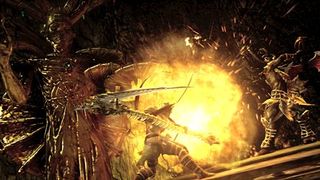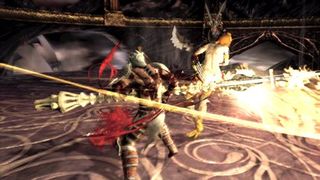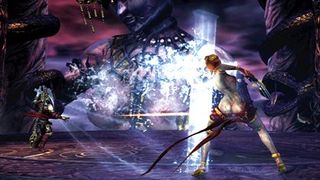God of War meets Dead Space in Hell. That’s how we first described Dante’s Inferno and it wouldn’t be risking the wrath of Hell to suggest that’s how EA’s infernal epic looks now.

However, reducing the game to comparisons no longer does it justice. Sure, it plays like God of War – something the developers admitted to us – and it’s made by the same studio that handled Dead Space, but thanks to the game’s unique vision of Hell, it’s unlike anything we’ve seen before.
“When it comes to the environments in the game, we’ve tried to be as faithful to the poem as we could,” explains Jonathan Knight, executive producer on Dante’s Inferno. “Some sections, such as the Wood of the Suicides, or the Styx Marsh and the lead-up to the City of Dis, are pretty accurately re-constructed in the game, based directly upon Dante’s descriptions of what he imagined.”
To give you some idea of what that might be, the trees in the Wood of the Suicides are made up of people who took their own lives, constantly twisted and petrified in torment. The road to the City of Dis is a similarly cheery place: here, sinners are trapped inside burning coffins, eternally scrabbling to escape. Sure beats warehouses, docks and generic urban sprawls.

This adherence to the poem extends to the characters. Figures such as King Minos (judge of the dead), Phlegyas (guides Dante and Virgil to Hell) and Charon (ferries the dead across the River Styx) appear pretty much as they are in The Divine Comedy. In fact, Knight is keen to point out that “only when it comes to the story, and to the sins of Dante and his dark past, did we feel the need to really deviate and add new layers”.
He goes on to give the reason for this, saying: “We wanted to make an action game, and so it was important to create drama and conflict. Rather than a simple pilgrimage to find Beatrice, we made it into a rescue mission to save Beatrice from the clutches of Hell. We also gave a bigger part to Lucifer, made him a strong antagonist, and it sort of grew from there.”
Of course, the biggest departure from the poem is Dante appearing as a war-bloodied, self-wounding Knight of the Crusades and not a politically savvy pre-Renaissance poet. Let’s face it: sharp, 14th Century Italian literature doesn’t sell games. This is where the God of War comparisons start to kick in. Dante’s Inferno is a violent, third-person action game with a flawed hero and a slick, simple combo system. Even the buttons are the same as the ones found in God of War. However, instead of reeling in horror when confronted with the question of similarity to Sony’s multi-million dollar franchise, the developers at Visceral actually welcome the comparisons.
Sign up to the 12DOVE Newsletter
Weekly digests, tales from the communities you love, and more
“It’s fair and flattering” says Knight. “We are obviously making a game in the third-person story-driven melee combat genre, and games like God of War, Devil May Cry and Ninja Gaiden are among the best in that class. We are honoured to be mentioned in that company. If the controls remind people of those games, then we hope that’s a good thing for gamers. What we’re focused on are the things that set Dante’s Inferno apart from the crowd.”

And what sets Dante’s apart? Technically, the game does look and play very smoothly. The team has already pledged its commitment to making sure it runs at a solid 60 frames per second, which – despite usually being a stat for the hardcore tech nerds – is important for reaction-based slashers. From a more gameplay-oriented perspective, Knight is keen to talk about the Righteousness system. Righteousness is morality with an action twist.
Most Popular


